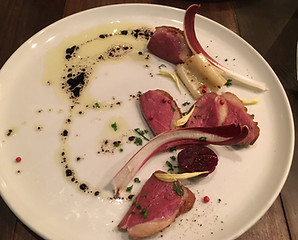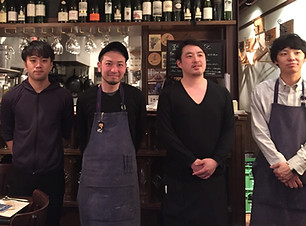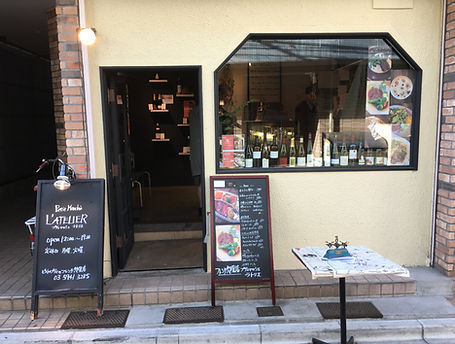Culinary Fusion in a Rising Culinary Neighborhood
Petit is a tiny French eatery 400 meters directly south of JR Nishi-Ogikubo Station on Yijo Dori, a narrow commercial street that bustles with commuters on foot and bicycle. Its mission is to create French cuisine that can only be made with Japanese ingredients. The menu is scribbled on a black chalk board in dense katakana with a few kanji, a lexicographical simulacrum of the Japanese ingredients suspended in a French culinary base. We asked the manager Nakazawa to explain an example of this mix of French and Japanese cuisine. He pointed to an item on the seasonal menu. This was Spanish mackerel (sawara) and milt of Pacific cod (madara no shirako), petit veil, with a yuzu and ponzu flavored beurre blanc sauce. “The yuzu gives it a Japanese flavor, and you are not likely to eat shirako abroad.”
Shirako is the sperm (milt) of the fish, and, indeed, this would not seem to be a common dish in French restaurants in the West. We ordered it, and it was delicious. It also came across as quite French, with the buttery sauce and fragrant yuzu softening and enhancing the bitter flavors of the salty, creamy, and slightly seared fish sperm.
Behind this culinary mélange, Petit represents the intimate collaboration between the more outgoing and entrepreneurial front house manager, Nakazawa Takafumi, and the reticent chef, Nozoe Shunji. There are two other young people who are helping in the kitchen. Matching classic French techniques with local seasonal ingredients, Petit serves innovative modern French cuisine at very reasonable prices. Their story shows how a restaurant adjusts to the local market while also contributing significantly to the image of Nishiogi as a rising culinary neighborhood in Tokyo.
The pair first ran a more casual restaurant in Tachikawa that served pasta alongside more classically French dishes. When they wanted to open a more serious restaurant, they chose the quieter neighborhood of Nishi-Ogikubo.
Matching the concept of the restaurant to the neighborhood has taken time. “There was a time when we were really unsure what to do,” he said. When the restaurant first opened four years ago, it was called Bistro Petit, but recently the term “Bistro” was removed, and the restaurant simply became Petit. Nakazawa explained that the image of the bistro came with an association of large portions and traditional French recipes. The restaurant was also decorated in a classic French style typical of the Basque region. The problem was, he said, “Japanese people are not used to that sense of a filling meal. After all people in Japan are used to Japanese cuisine.”
The emphasis on volume was suitable for young men like themselves, but the customers at Petit, however, were generally older, usually female, and often included families with children. They preferred lighter meals. “After many discussions with the chef, we changed the name from Bistrot Petit to just Petit, and we tried to bring in more of the essence of Japaneseness into the cuisine. The food is less heavy and it has more of a taste of Japan in it.”
Clearly this can also be understood as a strategy of distinguishing Petit from the numerous small bistros that have popped up in the area around Nishiogi Station. The neighborhood has sometimes even called the “bistro battleground.”
The shift from a sharing-style bistro to a course-menu style restaurant is related to the nature of the customers in Nishiogi, Nakazawa explained. “The customers in Nishiogi have a taste for good food,” he said. “They eat in a variety of places, from a high end restaurant to a standing and drinking izakaya. So, I suppose that has fattened their tongues [made them picky eaters]. I have to think about ways of making a menu with original cuisine. After talking things over, we think that Nishiogi’s customers are seeking quality over quantity. And when elevating quality, you have to think about the taste.”
As for the taste that people prefer he believes it is one that enhances the flavor of the original ingredients. “If it is cabbage it should taste like cabbage.”
While showing us this month's menu, Nakazawa explained that it is a fusion of French and Japanese culinary sensibilities. "We want to be bold. For example, like the familiar ‘yellowtail stewed with radish’ (buri daikon). It is spiced with flowering shiso, roasted pepper buds, things like that…. The yellowtail is thoroughly marinated, then lightly singed with a burner. Using the paste of clams, we draw the essence of clams into the broth in which the radish is sitting, stewing it slowly to allow it to soak up the taste of the clams. Basically, the way we see it, French and Japanese dishes are just two sides of one whole. It is just the way we say things. We have something like vegetable terrine, which also is like ‘jellied broth’ (nikogori). I think the approach is similar. So those who are on the forefront of Japanese or French cooking, I don’t think they want to do some type of cooking that preserves traditions. We want to take advantage of the techniques and produce something more suitable for the present era. "
“Another dish that shows a fusion with Japanese cuisine is this marinated tuna. We take the very familiar tuna steeped in soy sauce and we marinate it in olive oil. And, for a sauce we use an avocado puree which, we think, makes it French. We bring something into the appetizers that is not completely Japanese, but is a dish with a little Japanese essence. As for the main dish, people of course come here to eat French. So we do something that is strictly French, like the Rossini style filet mignon topped with a poêlé of foie gras and a truffle infused Périgueux sauce. This is a real classic from long ago. With the main dish, we don’t want to disappoint people’s expectations to eat something genuinely French. But, with the appetizers, we lightly bring in elements of the Japanese taste.”
Nakazawa emphasized that they want to produce a full course dinner for only 4,000 yen, so they have to consider many issues. Moreover, for their Nishiogi dinners, a full course French dinner can be heavy. “So, I try to make the whole thing as light as possible, so they are still able to eat dessert.”
Nakazawa emphasized that though he tries out different things, the background is always French cuisine. They learned their cooking in hotels and restaurants in Japan, they said, and while Japanese chefs of French cuisine used to have to travel to France to learn their trade, it is now possible to develop these skills at restaurants in Japan. “Of course, to get a feel for the atmosphere and the local landscape, you need to go to France, but you can learn enough in Japan.”
Still in order to better understand the culture he travels to France once a year. He is then better able to chat with his customers about France. “Like ‘this is how it is over there, or this is a this or that,’ I enjoy making that kind of conversation.”
“Whether the customer is a Japanese or a foreigner they want to taste special Japanese ingredients. So, we make French cuisine according to the local ingredients.” The menu changes each month and makes use of seasonal ingredients. For example, Spanish mackerel, yellowtail and daikon radishes are all seasonal ingredients on the winter menu.
Chef Nozoe decides the menu and creates the dishes. We asked him what attracted him to French cuisine. “I liked the taste of French cuisine, but it also looked really good on the plate. When you are making French cuisine, for example the plate of shirako we were talking about just now, it takes three days to make this dish. It takes a day to make the broth, and then two days to let it age. French cuisine is something that cannot be done in day. It must be constructed out of many elements. With Italian, you can just boil the pasta and pair it with a sauce and it is done. Making French cuisine in this [complex] way makes me feel happy.”
“With something like soup stock, it is also different in France and in Japan. In French cooking the sauce -- for instance with a beef filet -- the sauce is the most important item in the dish. In Japanese cuisine you also see the importance of broth. This yuzu sauce, for example, it's a fish soup. I am using beurre blanc sauce based on a fumet du poisson, I am also using Japanese bonito broth. I also use yuzu, so it is really a mix. So really, it is fusion. "
Given that he does a fusion style of cuisine, we asked if he sees French and Japanese cuisine as compatible. “I would say yes,” Nozoe said. “I have not done culinary training in France, but my friends who come back tell me stories. The French will simply say if it is made in France it is French. For example, they will use soy sauce. ‘Japanese soy sauce is delicious, why not use it,’ they say. Japanese will think that you cannot use soy sauce in French food, but we are being told by the French, ‘why not use it, since you have it right beside you.’ So, we, who are in Japan, use everything at our disposal, since it is compatible. The food in our place is fusion, like what you see now.”
The restaurant also serves wine pairing courses. Nakazawa chooses the wine. We asked if they sometimes paired the food with sakes or perhaps Japanese made wines. Sake is occasionally paired with dishes. However Japanese grape wines are served less often. This is because it is not easy to find Japan-produced wines with a good price for value. Most wines are imported.
“We have all types of wine,” he said. “But this is not a place for wine experts. It's place to enjoy drinking wine. The axis for choosing wine is the tastes of all the foods together. One day you might have only light wines. Another day you might have only heavier ones. In the summer, there would be more light wines to go with the lighter sauces, but in the winter more full-bodied wines to go with the heavier sauces. So, there is a seasonal quality to choosing the wines. That is the axis.”
Petit has become a popular shop in Nishiogi, and in November 2016 they also opened the take-out shop "Petit Marche Atelier." The shop sells many of the tasty items that are from the restaurant menu.
With two shops in Nishiogi, the working hours for the team, however, are very long, often from early in the morning until late at night. Mondays are holidays, and recently they have adopted a system of taking off two more days every month, including one Sunday. “Because for this type of job, it is impossible to do a good job unless one has some private time. When the restaurant only has weekday holidays, one’s world view becomes more and more narrow. So, we decided to close at least one Sunday. Actually, it is a system that we adopted last year. That is the day when you can see your family and the friends you usually do not see. If you don’t at least have off one Sunday a month, then what are you working for? So, we all take the day off.”
Petit’s concept is one in which "customers who visit can enjoy eating and drinking, and through eating and drinking make their lives enjoyable.” In order to fulfill this ideal, the team must think deeply about cooking, menus and drink pairings. They also have had to rethink the way they work.
In the current era of transnational flows of foods, chefs and customers, culinary fusion is not a new idea. Paris’s Michelin-starred restaurant kitchens are staffed by many Japanese chefs who bring Japanese flavors to French haute cuisine. However, by developing a very high level of French cuisine with original Japanese elements at a reasonable price Petit has contributed to the reputation of Nishiogi as a rising culinary neighborhood suitable for more price conscious diners (James Farrer, March 4, 2017).













